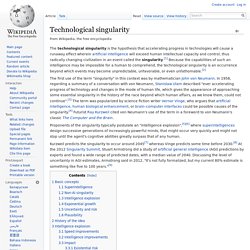

Accelerating change. In futures studies and the history of technology, accelerating change is a perceived increase in the rate of technological (and sometimes social and cultural) progress throughout history, which may suggest faster and more profound change in the future.

While many have suggested accelerating change, the popularity of this theory in modern times is closely associated with various advocates of the technological singularity, such as Vernor Vinge and Ray Kurzweil. Early theories[edit] In 1938, Buckminster Fuller introduced the word ephemeralization to describe the trends of "doing more with less" in chemistry, health and other areas of industrial development.[1] In 1946, Fuller published a chart of the discoveries of the chemical elements over time to highlight the development of accelerating acceleration in human knowledge acquisition.[2] The Law of Accelerating Returns.
Book Cover. Technological singularity. The technological singularity is the hypothesis that accelerating progress in technologies will cause a runaway effect wherein artificial intelligence will exceed human intellectual capacity and control, thus radically changing civilization in an event called the singularity.[1] Because the capabilities of such an intelligence may be impossible for a human to comprehend, the technological singularity is an occurrence beyond which events may become unpredictable, unfavorable, or even unfathomable.[2] The first use of the term "singularity" in this context was by mathematician John von Neumann.

Proponents of the singularity typically postulate an "intelligence explosion",[5][6] where superintelligences design successive generations of increasingly powerful minds, that might occur very quickly and might not stop until the agent's cognitive abilities greatly surpass that of any human. Basic concepts Superintelligence Non-AI singularity. Exponential Growth.
Moore's Law. Moore's Law. Use Of Technology.